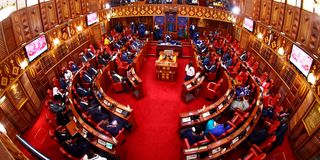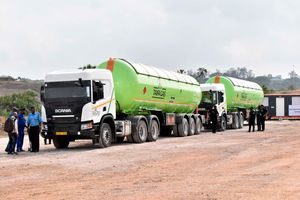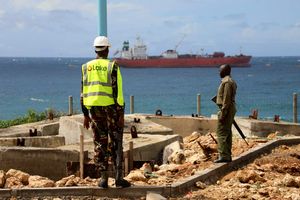
The Senate in a past session.
Senators have flagged the government's decision to award a 31-year lease agreement to a foreign firm for the construction of a Sh17.7 billion cooking gas handling facility in Mombasa.
The development comes after the Ministry of Energy and Petroleum relieved the Kenya Pipeline Company (KPC) and handed over the project to Asharami Synergy, a subsidiary of the Sahara Group in Nigeria.
Under the arrangement, the Nigerian firm will construct and operate the facility with a capacity of 30,000 tonnes on a 31-year lease deal. The project entails the construction of bulk importation, storage and handling facilities for liquefied petroleum gas (LPG).
This is despite KPC already spending Sh192.64 million of taxpayers’ money in undertaking feasibility studies, including demand surveys, environmental and social impact assessment, and front-end engineering.
Raising the alarm, Busia Senator Okiya Omtatah questioned the decision to transfer the implementation of the project from the KPC, a government agency, to a private company.
The lawmaker wanted Energy Cabinet Secretary Opiyo Wandayi to explain the circumstances that necessitated the move to hand over the project to Asharami Synergy rather than allow KPC to undertake the project.
“Can the minister state reasons why the plan by KPC to develop the cooking gas handling facility in Mombasa was quashed and the project handed over to Asharami Synergy?” posed Mr Omtatah.
The senator also hard-pressed CS Wandayi to come clean on whether Kenya Petroleum Refineries Limited (KPRL) followed the law and laid down procedure in leasing the 23.19 acres of public land, on which the facility lies, to the foreign firm.
“Kindly explain the process of selection of a company to develop the gas handling facility, including details on all received proposals as well as justifications for contracting Asharami Synergy to construct and operate the facility on a 31-year lease arrangement,” he said.
Appearing before the Senate Energy Committee, CS Wandayi defended the deal, saying the ministry was advised to explore private sector participation in implementing the project.
He said the move to hand over the project to a private firm was agreed on in order to deliver the project within the required timelines.
Nonetheless, CS Wandayi told the committee chaired by Siaya Senator Dr Oburu Oginga that the lease arrangement to the private sector was expressly provided for in a Cabinet directive of October 2023.
He said the agreement with Asharami has yield-up provisions for where the facilities shall revert to the government of Kenya through KPC and KPRL.
However, he admitted that the two State agencies and Asharami are yet to meet to discuss the modalities of sharing Information.
“The government opted for the private sector participants given the existing budgetary constraints. This method will also deliver the project within the required timelines,” said Mr Wandayi.
The former Ugunja MP pointed out that the project is a component of the LPG National Growth strategy aimed at increasing LPG consumption in the country from 7.5 to 15 kilogrammes per capita by 2028.
The strategy, he said, includes the development of bulk LPG infrastructure, LPG for public institutions of learning and LPG for subsidised cylinders.
Mr Wandayi told the committee that Asharami was selected through the specially permitted procurement procedure, with KPRL granted approval by the National Treasury to use the procedure.
He disclosed that six bidders were invited to submit their proposals, including Total Energies Limited, Rubis Energy Kenya Limited, Galana Energies Limited, Gulf Energy Limited, Vivo Energy Limited and Asharami Synergy Limited.
“Two bids were received from Gulf Energy Limited and Asharami Synergy, and following an evaluation process, Asharami Synergy Limited was responsive to the bid,” he said.
The minister added that the law was followed in leasing the 23.19 acres of public land, with the approval sought granted in line with established procedures, which was done in accordance with the National Treasury Circular Number 1 of 2025 on requirements for seeking approval to lease public assets.
He pointed out that the approval granted for the lease of the land was done through a strategic directive from the KPC and KPRL boards.
Also included in the decision were the Head of Public Service, the National Land Commission, the Office of the Attorney General and the National Treasury.






